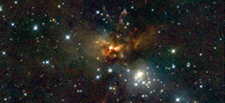 Our activities in optical-IR astronomy have been rapidly growing in recent years. We have a dozen researchers (staff, postdocs and students) who are pursuing their own interests, ranging from asteroids to distant galaxies. Our institute has access to Canada-France-Hawaii Telescope (CFHT), one of the most effective and productive 4-m telescopes in the world. To stay competitive in an era of the new 8-10m telescopes, CFHT has unique instruments such as MegaCam, WIRCam (wide field cameras at optical and near-infrared wavelengths, respectively) and ESPaDOnS (spectropolarimeter at high spectral resolution). Our institute members have been using those instruments for a variety of topics: photometric redshifts of distant galaxies, galaxy clusters, interacting galaxies, searching for afterglows of gamma-ray bursts, star formation in nearby galaxies, circumstellar environments of young and evolved stars, extremely low-mass objects such as brown dwarfs, triggered star formation etc. MegaCam and WIRCam will also be used for optical follow up observations of galaxy clusters observed by AMiBA (Array for Microwave Background Anisotropy), which has been recently developed by our institute.
Our activities in optical-IR astronomy have been rapidly growing in recent years. We have a dozen researchers (staff, postdocs and students) who are pursuing their own interests, ranging from asteroids to distant galaxies. Our institute has access to Canada-France-Hawaii Telescope (CFHT), one of the most effective and productive 4-m telescopes in the world. To stay competitive in an era of the new 8-10m telescopes, CFHT has unique instruments such as MegaCam, WIRCam (wide field cameras at optical and near-infrared wavelengths, respectively) and ESPaDOnS (spectropolarimeter at high spectral resolution). Our institute members have been using those instruments for a variety of topics: photometric redshifts of distant galaxies, galaxy clusters, interacting galaxies, searching for afterglows of gamma-ray bursts, star formation in nearby galaxies, circumstellar environments of young and evolved stars, extremely low-mass objects such as brown dwarfs, triggered star formation etc. MegaCam and WIRCam will also be used for optical follow up observations of galaxy clusters observed by AMiBA (Array for Microwave Background Anisotropy), which has been recently developed by our institute.
Some of us also pursue our interests using other telescopes (Subaru, Gemini, Spitzer Space Telescope, Lulin 1-m Telescope etc.) by both attaining our own observing time and accessing archival data. Recent research topics using these telescope include: weak-lensing in galaxy clusters, jets, winds and protoplanetary disks associated with young stellar objects , massive star-forming regions and HII regions, and searching for optical afterglows of gamma-ray bursts.










